Report on Human Resource Management: Key Issues and Challenges
VerifiedAdded on 2019/09/16
|7
|1809
|356
Report
AI Summary
This report provides a comprehensive analysis of key issues in human resource management (HRM). It delves into the concepts of human capital, examining its definition, trends, and challenges, including demographic changes, growth focus, and intangible assets. The report also explores the significance of employment, discussing the importance of recruiting the right candidates and the challenges associated with it. Furthermore, it addresses the critical issue of skill gaps, defining it as the discrepancy between required and possessed skills, and its impact on organizational performance. The report also examines the recruitment of young people and its effect on human capital. It concludes by emphasizing the importance of HRM in maximizing employee performance and highlights the relationship between human capital and employment opportunities, including labor turnover and skilled labor requirements. The report suggests that addressing skill gaps through training and development is essential for organizational success and competitive advantage. Finally, the report references several academic sources to support the claims and analyses presented.
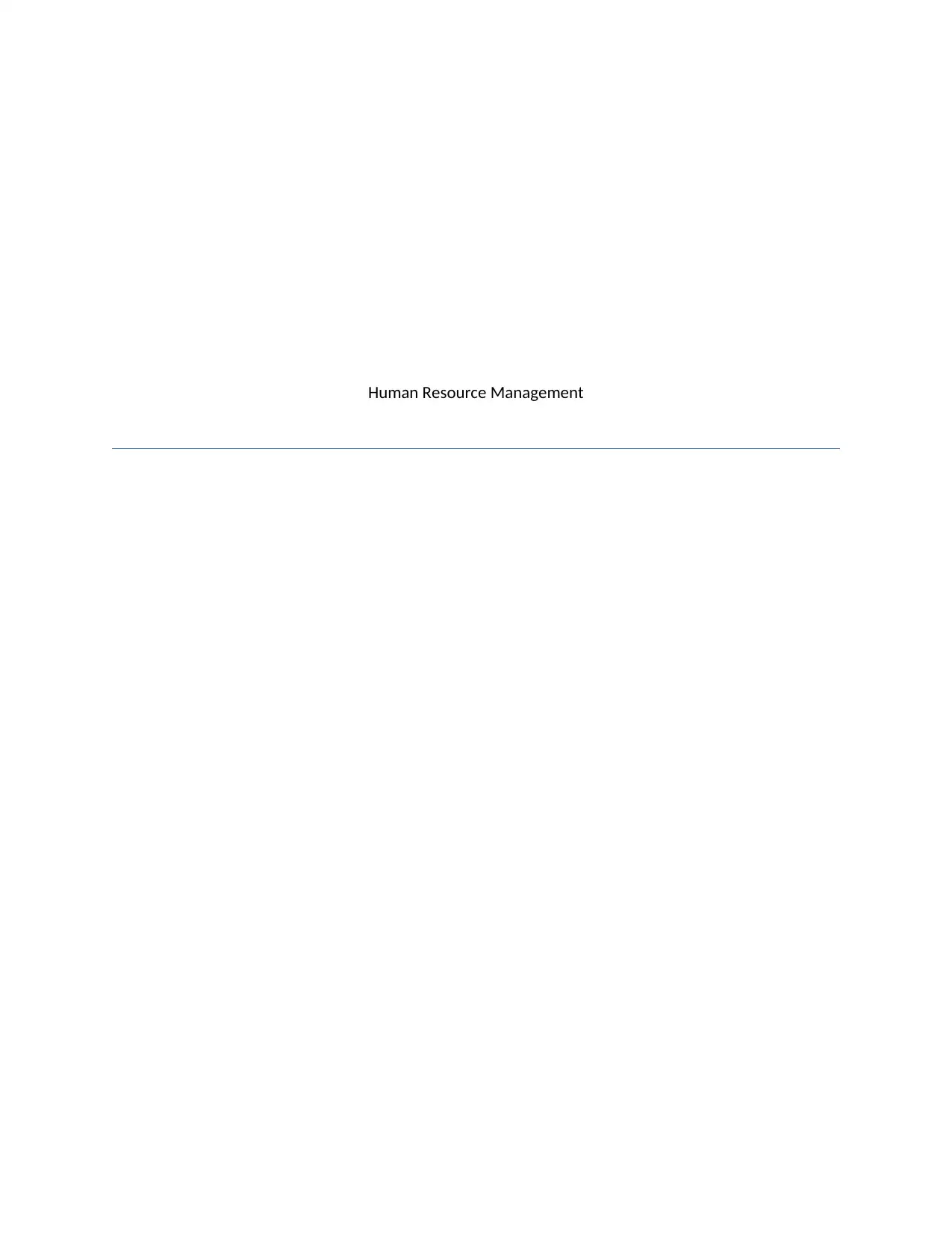
Human Resource Management
Paraphrase This Document
Need a fresh take? Get an instant paraphrase of this document with our AI Paraphraser
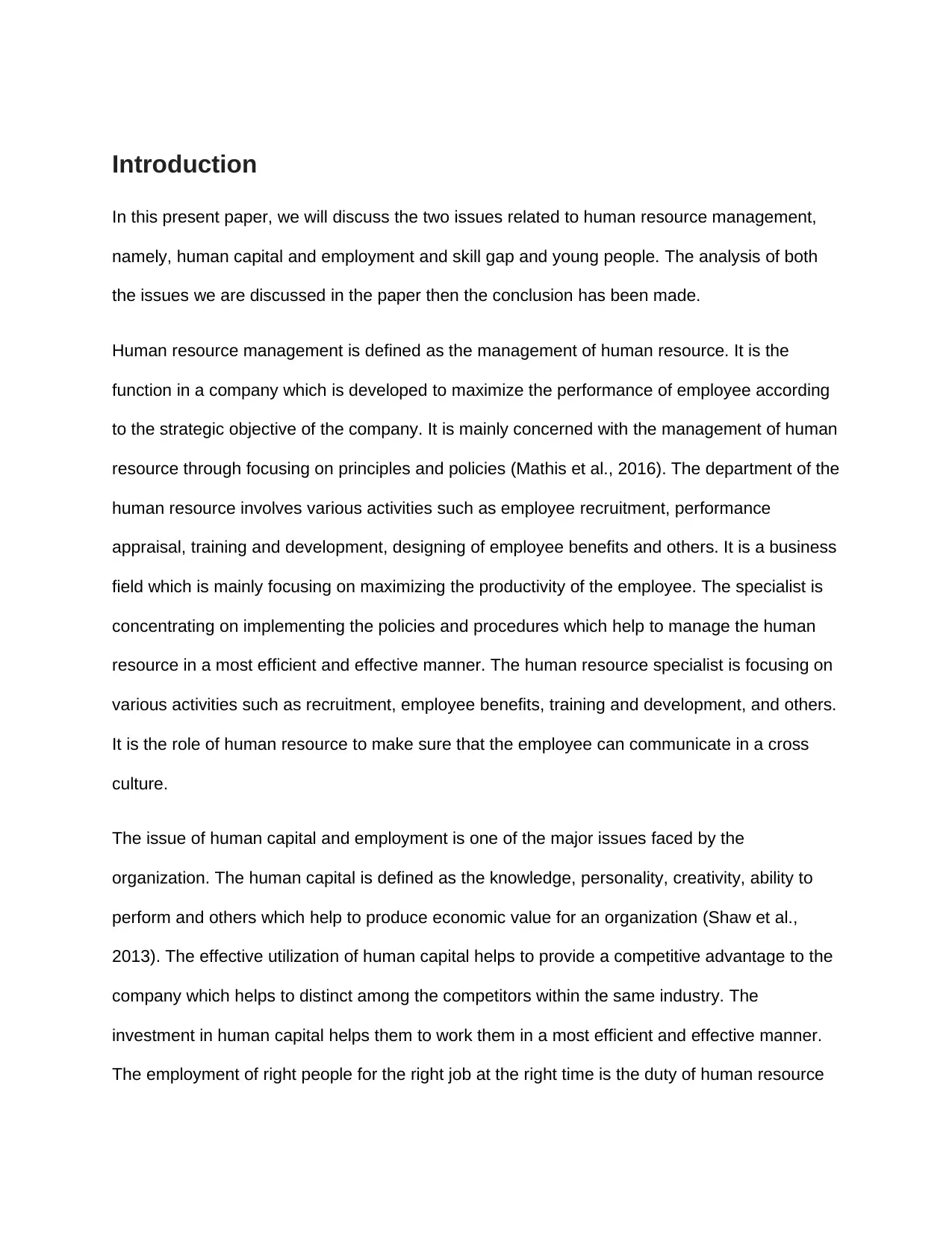
Introduction
In this present paper, we will discuss the two issues related to human resource management,
namely, human capital and employment and skill gap and young people. The analysis of both
the issues we are discussed in the paper then the conclusion has been made.
Human resource management is defined as the management of human resource. It is the
function in a company which is developed to maximize the performance of employee according
to the strategic objective of the company. It is mainly concerned with the management of human
resource through focusing on principles and policies (Mathis et al., 2016). The department of the
human resource involves various activities such as employee recruitment, performance
appraisal, training and development, designing of employee benefits and others. It is a business
field which is mainly focusing on maximizing the productivity of the employee. The specialist is
concentrating on implementing the policies and procedures which help to manage the human
resource in a most efficient and effective manner. The human resource specialist is focusing on
various activities such as recruitment, employee benefits, training and development, and others.
It is the role of human resource to make sure that the employee can communicate in a cross
culture.
The issue of human capital and employment is one of the major issues faced by the
organization. The human capital is defined as the knowledge, personality, creativity, ability to
perform and others which help to produce economic value for an organization (Shaw et al.,
2013). The effective utilization of human capital helps to provide a competitive advantage to the
company which helps to distinct among the competitors within the same industry. The
investment in human capital helps them to work them in a most efficient and effective manner.
The employment of right people for the right job at the right time is the duty of human resource
In this present paper, we will discuss the two issues related to human resource management,
namely, human capital and employment and skill gap and young people. The analysis of both
the issues we are discussed in the paper then the conclusion has been made.
Human resource management is defined as the management of human resource. It is the
function in a company which is developed to maximize the performance of employee according
to the strategic objective of the company. It is mainly concerned with the management of human
resource through focusing on principles and policies (Mathis et al., 2016). The department of the
human resource involves various activities such as employee recruitment, performance
appraisal, training and development, designing of employee benefits and others. It is a business
field which is mainly focusing on maximizing the productivity of the employee. The specialist is
concentrating on implementing the policies and procedures which help to manage the human
resource in a most efficient and effective manner. The human resource specialist is focusing on
various activities such as recruitment, employee benefits, training and development, and others.
It is the role of human resource to make sure that the employee can communicate in a cross
culture.
The issue of human capital and employment is one of the major issues faced by the
organization. The human capital is defined as the knowledge, personality, creativity, ability to
perform and others which help to produce economic value for an organization (Shaw et al.,
2013). The effective utilization of human capital helps to provide a competitive advantage to the
company which helps to distinct among the competitors within the same industry. The
investment in human capital helps them to work them in a most efficient and effective manner.
The employment of right people for the right job at the right time is the duty of human resource
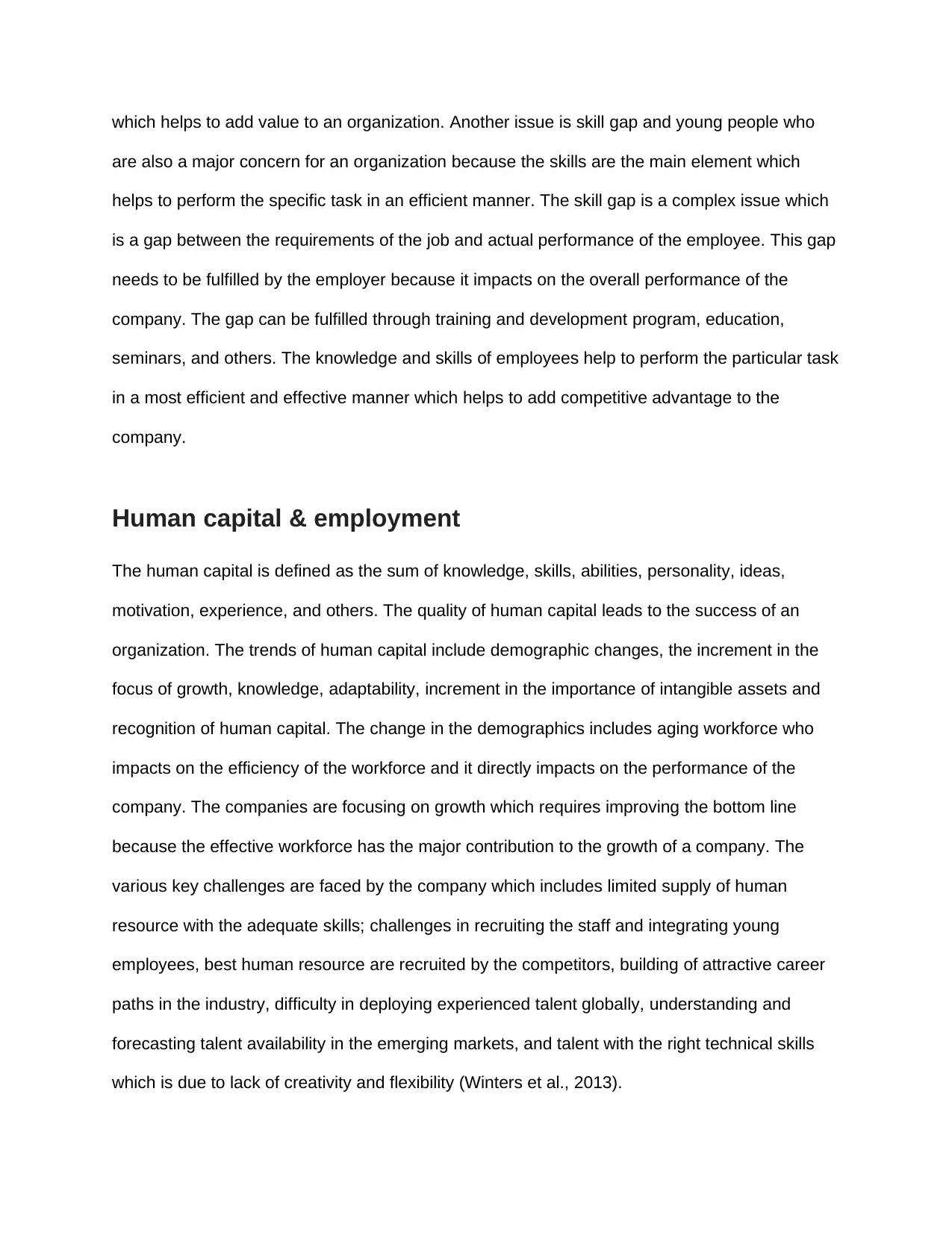
which helps to add value to an organization. Another issue is skill gap and young people who
are also a major concern for an organization because the skills are the main element which
helps to perform the specific task in an efficient manner. The skill gap is a complex issue which
is a gap between the requirements of the job and actual performance of the employee. This gap
needs to be fulfilled by the employer because it impacts on the overall performance of the
company. The gap can be fulfilled through training and development program, education,
seminars, and others. The knowledge and skills of employees help to perform the particular task
in a most efficient and effective manner which helps to add competitive advantage to the
company.
Human capital & employment
The human capital is defined as the sum of knowledge, skills, abilities, personality, ideas,
motivation, experience, and others. The quality of human capital leads to the success of an
organization. The trends of human capital include demographic changes, the increment in the
focus of growth, knowledge, adaptability, increment in the importance of intangible assets and
recognition of human capital. The change in the demographics includes aging workforce who
impacts on the efficiency of the workforce and it directly impacts on the performance of the
company. The companies are focusing on growth which requires improving the bottom line
because the effective workforce has the major contribution to the growth of a company. The
various key challenges are faced by the company which includes limited supply of human
resource with the adequate skills; challenges in recruiting the staff and integrating young
employees, best human resource are recruited by the competitors, building of attractive career
paths in the industry, difficulty in deploying experienced talent globally, understanding and
forecasting talent availability in the emerging markets, and talent with the right technical skills
which is due to lack of creativity and flexibility (Winters et al., 2013).
are also a major concern for an organization because the skills are the main element which
helps to perform the specific task in an efficient manner. The skill gap is a complex issue which
is a gap between the requirements of the job and actual performance of the employee. This gap
needs to be fulfilled by the employer because it impacts on the overall performance of the
company. The gap can be fulfilled through training and development program, education,
seminars, and others. The knowledge and skills of employees help to perform the particular task
in a most efficient and effective manner which helps to add competitive advantage to the
company.
Human capital & employment
The human capital is defined as the sum of knowledge, skills, abilities, personality, ideas,
motivation, experience, and others. The quality of human capital leads to the success of an
organization. The trends of human capital include demographic changes, the increment in the
focus of growth, knowledge, adaptability, increment in the importance of intangible assets and
recognition of human capital. The change in the demographics includes aging workforce who
impacts on the efficiency of the workforce and it directly impacts on the performance of the
company. The companies are focusing on growth which requires improving the bottom line
because the effective workforce has the major contribution to the growth of a company. The
various key challenges are faced by the company which includes limited supply of human
resource with the adequate skills; challenges in recruiting the staff and integrating young
employees, best human resource are recruited by the competitors, building of attractive career
paths in the industry, difficulty in deploying experienced talent globally, understanding and
forecasting talent availability in the emerging markets, and talent with the right technical skills
which is due to lack of creativity and flexibility (Winters et al., 2013).
⊘ This is a preview!⊘
Do you want full access?
Subscribe today to unlock all pages.

Trusted by 1+ million students worldwide
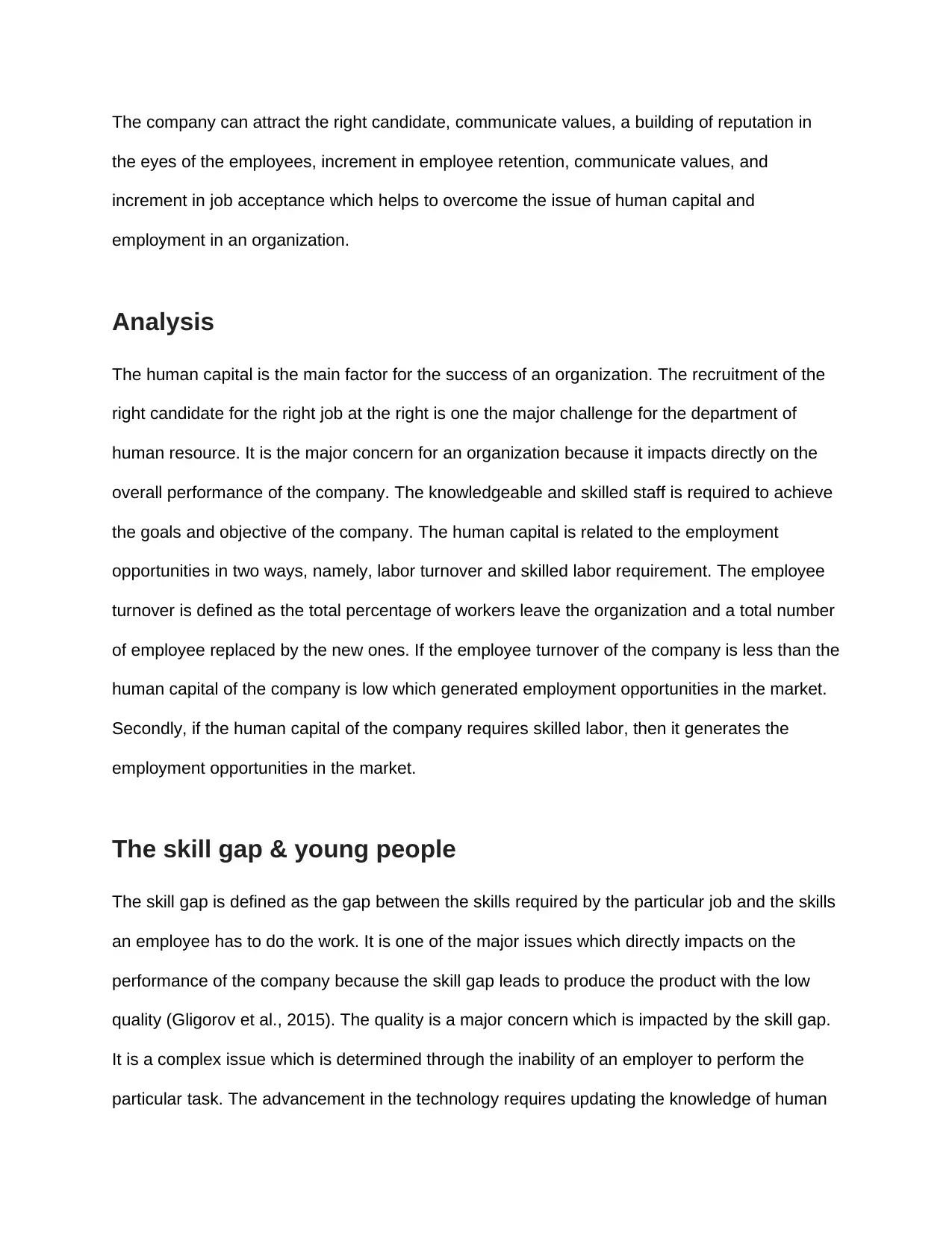
The company can attract the right candidate, communicate values, a building of reputation in
the eyes of the employees, increment in employee retention, communicate values, and
increment in job acceptance which helps to overcome the issue of human capital and
employment in an organization.
Analysis
The human capital is the main factor for the success of an organization. The recruitment of the
right candidate for the right job at the right is one the major challenge for the department of
human resource. It is the major concern for an organization because it impacts directly on the
overall performance of the company. The knowledgeable and skilled staff is required to achieve
the goals and objective of the company. The human capital is related to the employment
opportunities in two ways, namely, labor turnover and skilled labor requirement. The employee
turnover is defined as the total percentage of workers leave the organization and a total number
of employee replaced by the new ones. If the employee turnover of the company is less than the
human capital of the company is low which generated employment opportunities in the market.
Secondly, if the human capital of the company requires skilled labor, then it generates the
employment opportunities in the market.
The skill gap & young people
The skill gap is defined as the gap between the skills required by the particular job and the skills
an employee has to do the work. It is one of the major issues which directly impacts on the
performance of the company because the skill gap leads to produce the product with the low
quality (Gligorov et al., 2015). The quality is a major concern which is impacted by the skill gap.
It is a complex issue which is determined through the inability of an employer to perform the
particular task. The advancement in the technology requires updating the knowledge of human
the eyes of the employees, increment in employee retention, communicate values, and
increment in job acceptance which helps to overcome the issue of human capital and
employment in an organization.
Analysis
The human capital is the main factor for the success of an organization. The recruitment of the
right candidate for the right job at the right is one the major challenge for the department of
human resource. It is the major concern for an organization because it impacts directly on the
overall performance of the company. The knowledgeable and skilled staff is required to achieve
the goals and objective of the company. The human capital is related to the employment
opportunities in two ways, namely, labor turnover and skilled labor requirement. The employee
turnover is defined as the total percentage of workers leave the organization and a total number
of employee replaced by the new ones. If the employee turnover of the company is less than the
human capital of the company is low which generated employment opportunities in the market.
Secondly, if the human capital of the company requires skilled labor, then it generates the
employment opportunities in the market.
The skill gap & young people
The skill gap is defined as the gap between the skills required by the particular job and the skills
an employee has to do the work. It is one of the major issues which directly impacts on the
performance of the company because the skill gap leads to produce the product with the low
quality (Gligorov et al., 2015). The quality is a major concern which is impacted by the skill gap.
It is a complex issue which is determined through the inability of an employer to perform the
particular task. The advancement in the technology requires updating the knowledge of human
Paraphrase This Document
Need a fresh take? Get an instant paraphrase of this document with our AI Paraphraser
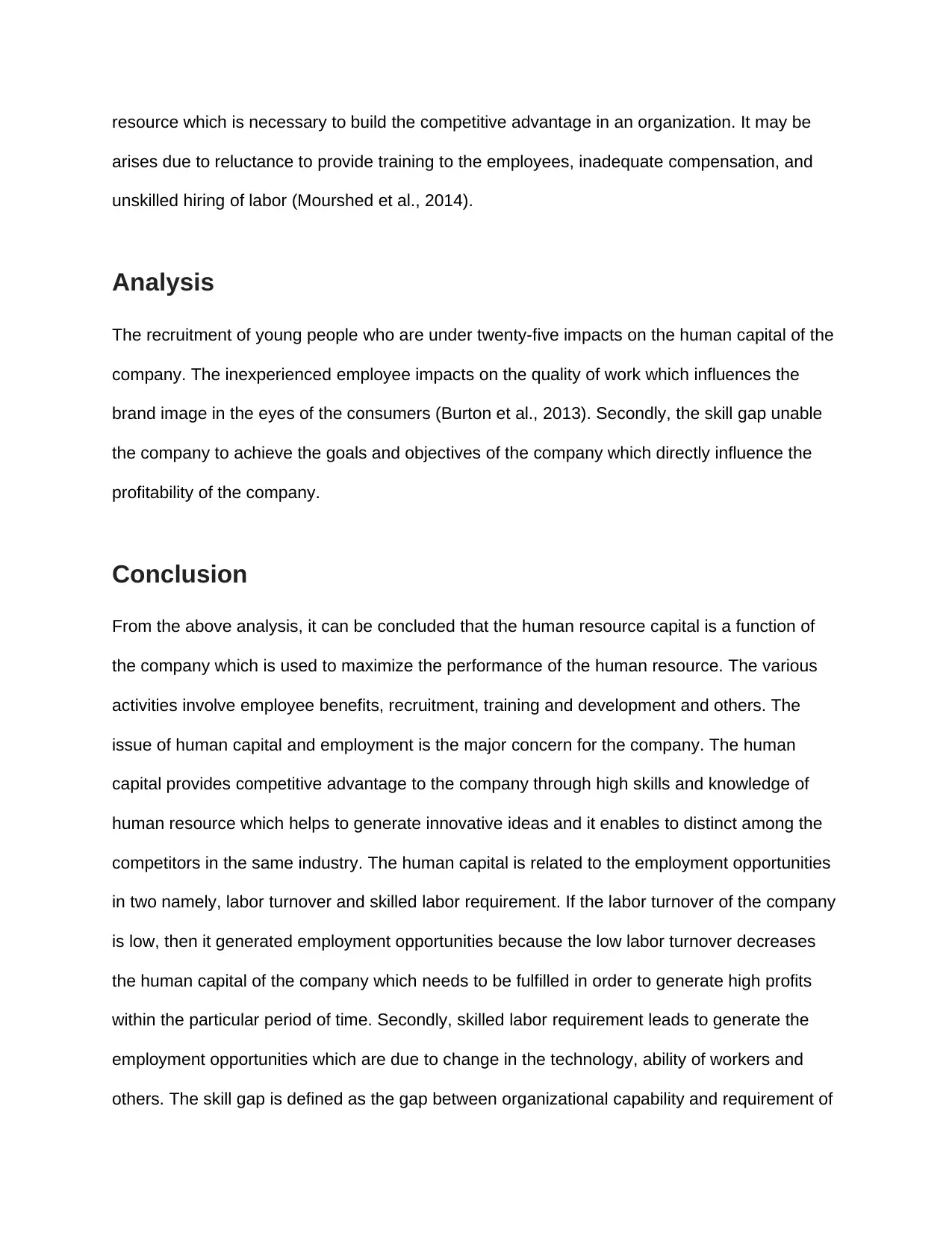
resource which is necessary to build the competitive advantage in an organization. It may be
arises due to reluctance to provide training to the employees, inadequate compensation, and
unskilled hiring of labor (Mourshed et al., 2014).
Analysis
The recruitment of young people who are under twenty-five impacts on the human capital of the
company. The inexperienced employee impacts on the quality of work which influences the
brand image in the eyes of the consumers (Burton et al., 2013). Secondly, the skill gap unable
the company to achieve the goals and objectives of the company which directly influence the
profitability of the company.
Conclusion
From the above analysis, it can be concluded that the human resource capital is a function of
the company which is used to maximize the performance of the human resource. The various
activities involve employee benefits, recruitment, training and development and others. The
issue of human capital and employment is the major concern for the company. The human
capital provides competitive advantage to the company through high skills and knowledge of
human resource which helps to generate innovative ideas and it enables to distinct among the
competitors in the same industry. The human capital is related to the employment opportunities
in two namely, labor turnover and skilled labor requirement. If the labor turnover of the company
is low, then it generated employment opportunities because the low labor turnover decreases
the human capital of the company which needs to be fulfilled in order to generate high profits
within the particular period of time. Secondly, skilled labor requirement leads to generate the
employment opportunities which are due to change in the technology, ability of workers and
others. The skill gap is defined as the gap between organizational capability and requirement of
arises due to reluctance to provide training to the employees, inadequate compensation, and
unskilled hiring of labor (Mourshed et al., 2014).
Analysis
The recruitment of young people who are under twenty-five impacts on the human capital of the
company. The inexperienced employee impacts on the quality of work which influences the
brand image in the eyes of the consumers (Burton et al., 2013). Secondly, the skill gap unable
the company to achieve the goals and objectives of the company which directly influence the
profitability of the company.
Conclusion
From the above analysis, it can be concluded that the human resource capital is a function of
the company which is used to maximize the performance of the human resource. The various
activities involve employee benefits, recruitment, training and development and others. The
issue of human capital and employment is the major concern for the company. The human
capital provides competitive advantage to the company through high skills and knowledge of
human resource which helps to generate innovative ideas and it enables to distinct among the
competitors in the same industry. The human capital is related to the employment opportunities
in two namely, labor turnover and skilled labor requirement. If the labor turnover of the company
is low, then it generated employment opportunities because the low labor turnover decreases
the human capital of the company which needs to be fulfilled in order to generate high profits
within the particular period of time. Secondly, skilled labor requirement leads to generate the
employment opportunities which are due to change in the technology, ability of workers and
others. The skill gap is defined as the gap between organizational capability and requirement of
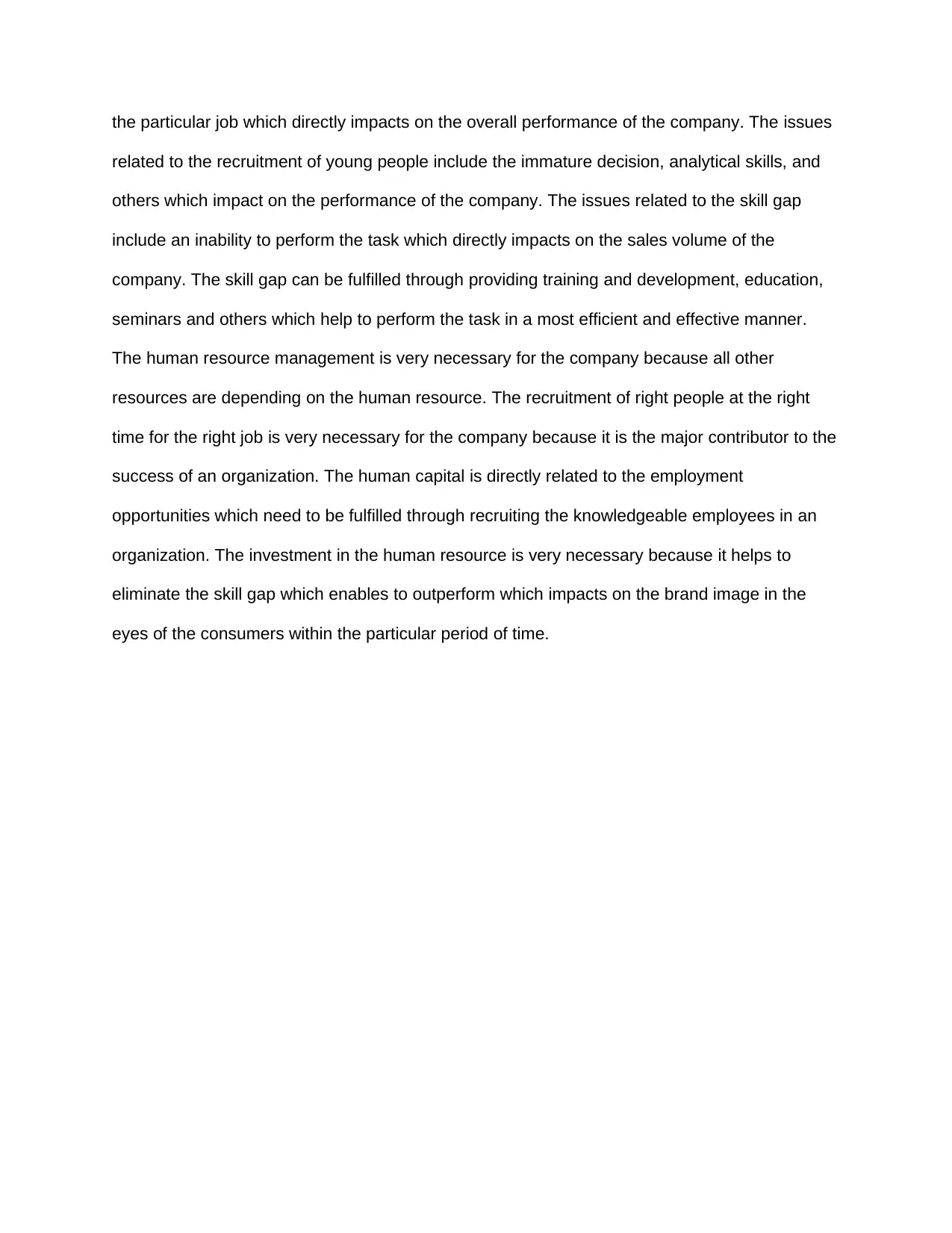
the particular job which directly impacts on the overall performance of the company. The issues
related to the recruitment of young people include the immature decision, analytical skills, and
others which impact on the performance of the company. The issues related to the skill gap
include an inability to perform the task which directly impacts on the sales volume of the
company. The skill gap can be fulfilled through providing training and development, education,
seminars and others which help to perform the task in a most efficient and effective manner.
The human resource management is very necessary for the company because all other
resources are depending on the human resource. The recruitment of right people at the right
time for the right job is very necessary for the company because it is the major contributor to the
success of an organization. The human capital is directly related to the employment
opportunities which need to be fulfilled through recruiting the knowledgeable employees in an
organization. The investment in the human resource is very necessary because it helps to
eliminate the skill gap which enables to outperform which impacts on the brand image in the
eyes of the consumers within the particular period of time.
related to the recruitment of young people include the immature decision, analytical skills, and
others which impact on the performance of the company. The issues related to the skill gap
include an inability to perform the task which directly impacts on the sales volume of the
company. The skill gap can be fulfilled through providing training and development, education,
seminars and others which help to perform the task in a most efficient and effective manner.
The human resource management is very necessary for the company because all other
resources are depending on the human resource. The recruitment of right people at the right
time for the right job is very necessary for the company because it is the major contributor to the
success of an organization. The human capital is directly related to the employment
opportunities which need to be fulfilled through recruiting the knowledgeable employees in an
organization. The investment in the human resource is very necessary because it helps to
eliminate the skill gap which enables to outperform which impacts on the brand image in the
eyes of the consumers within the particular period of time.
⊘ This is a preview!⊘
Do you want full access?
Subscribe today to unlock all pages.

Trusted by 1+ million students worldwide
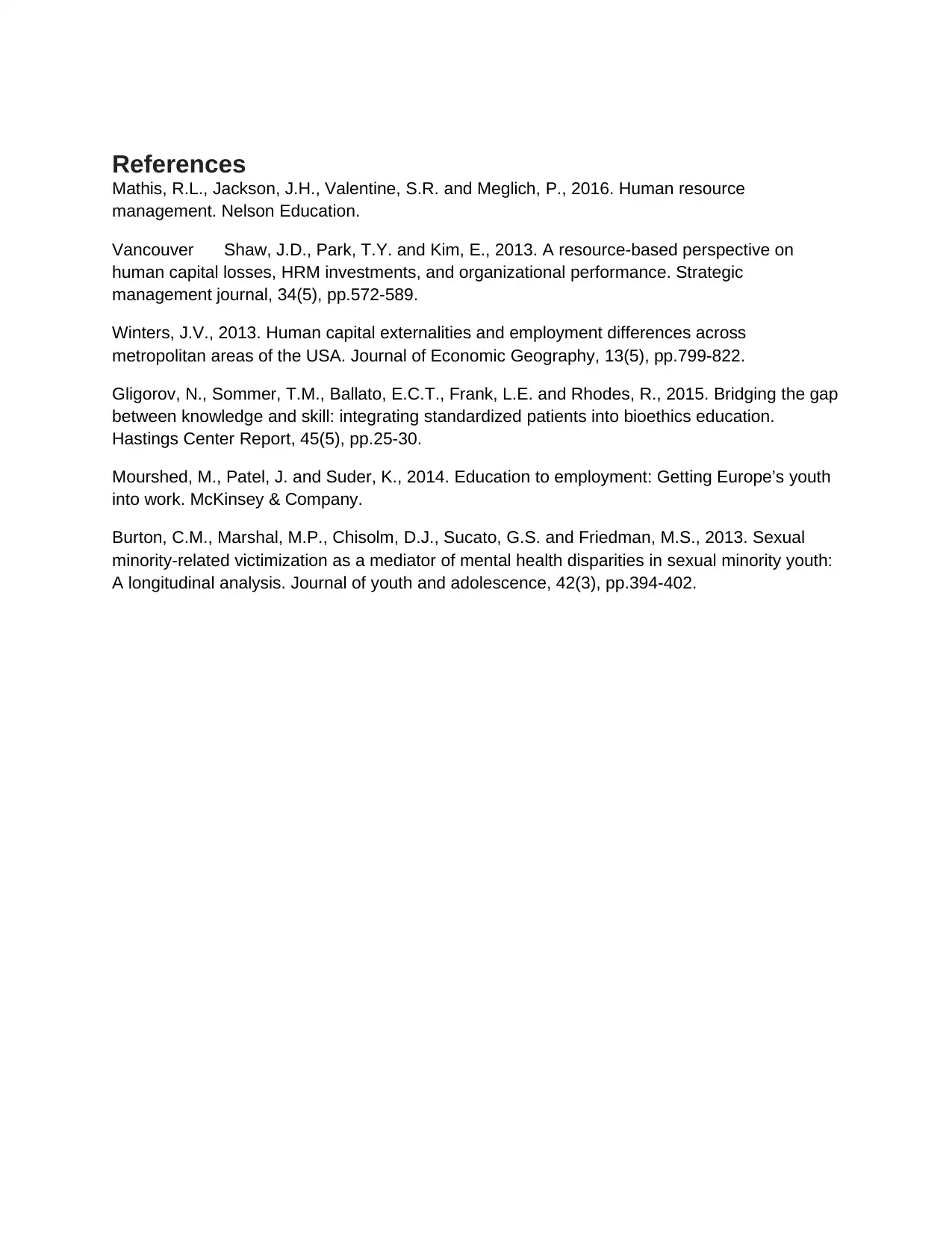
References
Mathis, R.L., Jackson, J.H., Valentine, S.R. and Meglich, P., 2016. Human resource
management. Nelson Education.
Vancouver Shaw, J.D., Park, T.Y. and Kim, E., 2013. A resource‐based perspective on
human capital losses, HRM investments, and organizational performance. Strategic
management journal, 34(5), pp.572-589.
Winters, J.V., 2013. Human capital externalities and employment differences across
metropolitan areas of the USA. Journal of Economic Geography, 13(5), pp.799-822.
Gligorov, N., Sommer, T.M., Ballato, E.C.T., Frank, L.E. and Rhodes, R., 2015. Bridging the gap
between knowledge and skill: integrating standardized patients into bioethics education.
Hastings Center Report, 45(5), pp.25-30.
Mourshed, M., Patel, J. and Suder, K., 2014. Education to employment: Getting Europe’s youth
into work. McKinsey & Company.
Burton, C.M., Marshal, M.P., Chisolm, D.J., Sucato, G.S. and Friedman, M.S., 2013. Sexual
minority-related victimization as a mediator of mental health disparities in sexual minority youth:
A longitudinal analysis. Journal of youth and adolescence, 42(3), pp.394-402.
Mathis, R.L., Jackson, J.H., Valentine, S.R. and Meglich, P., 2016. Human resource
management. Nelson Education.
Vancouver Shaw, J.D., Park, T.Y. and Kim, E., 2013. A resource‐based perspective on
human capital losses, HRM investments, and organizational performance. Strategic
management journal, 34(5), pp.572-589.
Winters, J.V., 2013. Human capital externalities and employment differences across
metropolitan areas of the USA. Journal of Economic Geography, 13(5), pp.799-822.
Gligorov, N., Sommer, T.M., Ballato, E.C.T., Frank, L.E. and Rhodes, R., 2015. Bridging the gap
between knowledge and skill: integrating standardized patients into bioethics education.
Hastings Center Report, 45(5), pp.25-30.
Mourshed, M., Patel, J. and Suder, K., 2014. Education to employment: Getting Europe’s youth
into work. McKinsey & Company.
Burton, C.M., Marshal, M.P., Chisolm, D.J., Sucato, G.S. and Friedman, M.S., 2013. Sexual
minority-related victimization as a mediator of mental health disparities in sexual minority youth:
A longitudinal analysis. Journal of youth and adolescence, 42(3), pp.394-402.
1 out of 7
Related Documents
Your All-in-One AI-Powered Toolkit for Academic Success.
+13062052269
info@desklib.com
Available 24*7 on WhatsApp / Email
![[object Object]](/_next/static/media/star-bottom.7253800d.svg)
Unlock your academic potential
Copyright © 2020–2025 A2Z Services. All Rights Reserved. Developed and managed by ZUCOL.




